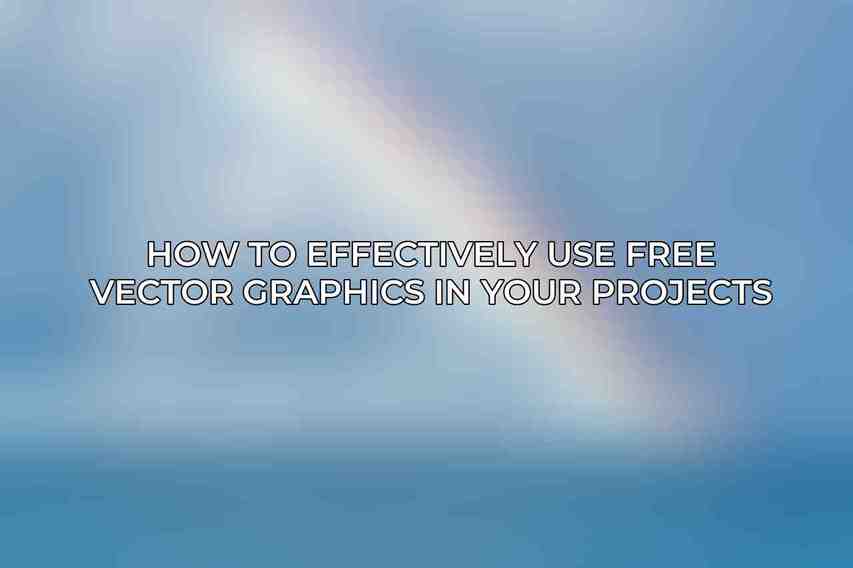When it comes to graphic design projects, incorporating free vector graphics can be a game-changer. These resources offer a wide range of benefits, from saving time and money to providing unlimited scalability without quality loss. Before delving into the intricacies of utilizing free vectors, it’s crucial to understand the basics. Vectors are graphic elements based on mathematical equations, allowing for infinite scalability without losing quality. However, as with any creative work, it’s essential to consider copyright and licensing concerns when using free vectors in your projects.
Finding and Selecting Free Vectors

A. Online repositories
- Freepik: Freepik is a popular platform offering a vast collection of free vectors for personal and commercial use.
- Vecteezy: Vecteezy provides a diverse selection of vectors, including illustrations, icons, and patterns.
- Pixabay: Known for its extensive library of high-quality images, Pixabay also offers a variety of free vectors.
- Pexels: Pexels not only offers free stock photos but also features a growing collection of vector graphics.
- Adobe Stock: Adobe Stock provides a mix of free and premium vector assets for creative projects.
B. Tips for selecting high-quality vectors
- Check resolution and file size: Opt for vectors with high resolutions to ensure crisp designs even after scaling.
- Preview the vector in different sizes: Testing the vector in various sizes helps assess its quality and versatility.
- Read user reviews: Feedback from other users can provide insights into the vector’s usability and quality.
- Consider the artist’s portfolio: Exploring the artist’s other work can give you a sense of their style and expertise.
Modifying and Using Free Vectors
A. Editing vectors in design software
When working with free vectors, having proficiency in graphic design software is essential. Popular tools for editing vectors include:
- Adobe Illustrator: A versatile tool for creating and editing vectors, offering a wide range of features and capabilities.
- Inkscape: An open-source vector graphics editor suitable for beginners and professionals alike.
- CorelDRAW: Known for its robust set of design tools, CorelDRAW is a go-to software for vector manipulation.
B. Techniques for modifying vectors
- Changing colors and gradients: Customize vectors by altering colors and gradients to suit your project’s aesthetic.
- Reshaping and scaling: Adjust vector shapes and sizes to fit specific design requirements.
- Adding effects and filters: Enhance vectors with various effects and filters for a unique visual impact.
- Creating new shapes and objects: Combine and manipulate vectors to create custom designs tailored to your project needs.
Design Integration

A. Tips for using vectors in different contexts
- Web design: Incorporate vectors into web layouts to enhance visual appeal and user experience.
- Print media: Utilize vectors in print materials like brochures and posters for high-quality, scalable graphics.
- Social media graphics: Create engaging social media visuals using vectors to attract and retain audience attention.
B. Color theory and vector integration
- Color harmonies: Understand color combinations to create visually appealing vector designs that resonate with viewers.
- Color contrast: Use color contrast to highlight important elements in your vectors and improve overall design impact.
- Color psychology: Harness the psychological effects of colors to evoke specific emotions or responses in your audience.
C. Balancing vector graphics with other elements
- Typography: Pair vectors with suitable typography to create a cohesive and visually appealing design.
- Images: Integrate vectors with images to create dynamic visual compositions that capture attention.
- Negative space: Utilize negative space effectively to balance vectors with other design elements and prevent visual clutter.
Best Practices for Using Free Vectors
A. Respecting copyright and attribution
- Understanding Creative Commons licenses: Familiarize yourself with different Creative Commons licenses to ensure compliance with usage terms.
- Citing the artist or source: Give proper credit to the vector artist or source as per the licensing requirements when using free vectors in your projects.
B. Optimizing vectors for different uses
- Resizing and resampling: Resize vectors appropriately for different platforms while maintaining optimal quality.
- File format selection: Choose the right file format (e.g., SVG, AI, EPS) based on the intended use and compatibility requirements.
C. Troubleshooting common issues
- Image distortion: Address image distortion issues by ensuring correct resizing and maintaining aspect ratios.
- File corruption: Protect vectors from file corruption by regularly backing up your design files.
- Compatibility problems: Verify vector compatibility across various software and platforms to avoid technical issues during design implementation.
the effective utilization of free vector graphics in your projects can elevate the quality and visual appeal of your designs. While free vectors offer numerous advantages, it’s equally important to be mindful of their limitations and proper usage practices. By following best practices, respecting copyrights, and optimizing vectors for diverse uses, you can leverage these resources to create stunning visuals across different mediums. For those looking to enhance their vector design skills further, exploring resources and tutorials can provide valuable insights and inspiration for future projects. Start incorporating free vectors creatively and watch your designs come to life with endless possibilities.
Frequently Asked Questions
What are free vector graphics?
Free vector graphics are digital illustrations that are created using mathematical equations, allowing them to be scaled to any size without losing quality.
How can I find free vector graphics for my projects?
There are several websites that offer free vector graphics, such as Freepik, Vecteezy, and Pixabay. You can also use search engines like Google to find free vector graphics.
What file formats are commonly used for vector graphics?
Common file formats for vector graphics include SVG (Scalable Vector Graphics), AI (Adobe Illustrator), and EPS (Encapsulated PostScript). These formats are scalable and can be edited without losing quality.
What software can I use to edit free vector graphics?
Popular software for editing vector graphics include Adobe Illustrator, Inkscape, and CorelDRAW. These programs allow you to customize and modify vector graphics to suit your project needs.
Can I use free vector graphics for commercial projects?
It depends on the license of the free vector graphics. Some websites offer free vector graphics for personal and commercial use, while others may have restrictions. Make sure to check the license terms before using free vector graphics in commercial projects.
